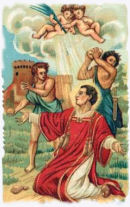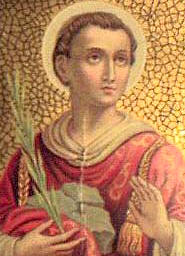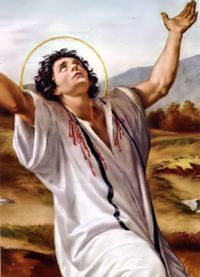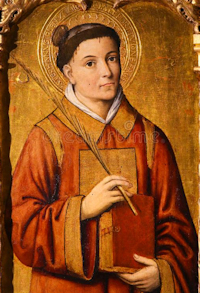Christmas: December 26th
Feast of St. Stephen, First Martyr
Other Titles: Boxing Day; Second Day within the Octave of the Nativity of the Lord (Christmas)
» Enjoy our Liturgical Seasons series of e-books!
Today is the Second day in the Octave of Christmas. The Church celebrates the Feast of St. Stephen, the first Christian martyr. Stoned outside Jerusalem, he died praying for his executioners. He was one of the seven deacons who helped the apostles; he was "filled with faith and with the Holy Spirit," and was "full of fortitude." The Church draws a comparison between the disciple and his Master, emphasizing the imitation of Christ even unto the complete gift of self. His name is included in the Roman Canon.
Station Church Information >>>
Feast of St. Stephen—Day Two "If you know what witness means, you understand why God brings St. Stephen, St. John, and the Holy Innocents to the crib in the cave as soon as Christ is born liturgically. To be a witness is to be a martyr. Holy Mother Church wishes us to realize that we were born in baptism to become Christ — He who was the world's outstanding Martyr." —Love Does Such Things, by Rev. M. Raymond, O.C.S.O.
![]()
 Saint Stephen is the first martyr of the Church, and is the patron of stonemasons, masons, bricklayers, deacons, headaches, and horses. His story comes from the Acts of the Apostles. He is usually pictured in deacon's vestments, holding the symbol of martyrdom, a palm branch. Sometimes he has a stone in his left hand, to indicate his death by stoning. He is depicted in many images wearing a wreath, which refers to the origin of his name, the Greek word Stephanos meaning "wreath."
Saint Stephen is the first martyr of the Church, and is the patron of stonemasons, masons, bricklayers, deacons, headaches, and horses. His story comes from the Acts of the Apostles. He is usually pictured in deacon's vestments, holding the symbol of martyrdom, a palm branch. Sometimes he has a stone in his left hand, to indicate his death by stoning. He is depicted in many images wearing a wreath, which refers to the origin of his name, the Greek word Stephanos meaning "wreath."
![]()
St. Stephen
 The deacon Stephen, stoned in Jerusalem two years after the death of Christ, has always been the object of very special veneration by the faithful. He is the first martyr. The account in the Acts of the Apostles relating his arrest and the accusations brought against him emphasize the parallel with our Saviour's trial; he was stoned outside the city wall and died, like his Master, praying for his executioners.
The deacon Stephen, stoned in Jerusalem two years after the death of Christ, has always been the object of very special veneration by the faithful. He is the first martyr. The account in the Acts of the Apostles relating his arrest and the accusations brought against him emphasize the parallel with our Saviour's trial; he was stoned outside the city wall and died, like his Master, praying for his executioners.
Stephen belongs to the group of seven deacons whom the Apostles associated with their work in order to lighten their load. He was "filled with faith and with the Holy Spirit," "full of grace and strength" he showed himself as a man of God, radiating divine grace and apostolic zeal. As the first witness to Christ he confronted his opponents with quiet courage and the promise made by Jesus (Mark 13.11) was fulfilled: ". . .Disputing with Stephen they were not able to resist the wisdom and the spirit that spoke."
In St. Stephen, the first martyr, the liturgy emphasizes the imitator of Christ even to the extent of the complete gift of self, to the extent of that great charity which made him pray in his suffering for his executioners. By establishing the feast on the day after Christmas the Church draws an even closer comparison between the disciple and the Master and thus extends his witness to the whole mission of the redeeming Messiah.
Professing the Christian Faith Demands the Heroism of the Martyrs
 On the day after the solemnity of Christmas, we celebrate today the feast of St. Stephen, deacon and first martyr. At first glance, to join the memory of the "protomartyr" and the birth of the Redeemer might seem surprising because of the contrast between the peace and joy of Bethlehem and the tragedy of St. Stephen, stoned in Jerusalem during the first persecution against the nascent Church.
On the day after the solemnity of Christmas, we celebrate today the feast of St. Stephen, deacon and first martyr. At first glance, to join the memory of the "protomartyr" and the birth of the Redeemer might seem surprising because of the contrast between the peace and joy of Bethlehem and the tragedy of St. Stephen, stoned in Jerusalem during the first persecution against the nascent Church.
In reality, this apparent opposition is surmounted if we analyze in greater depth the mystery of Christmas. The Child Jesus, lying in the cave, is the only-begotten Son of God who became man. He will save humanity by dying on the cross.
Now we see Him in swaddling clothes in the manger; after His crucifixion, He will again be wrapped in bandages and placed in the sepulcher. It is no accident that the Christmas iconography sometimes represents the divine newborn Child lying in a small sarcophagus, to indicate that the Redeemer was born to die, He was born to give His life in ransom for all.
St. Stephen was the first to follow in the steps of Christ with martyrdom: like the divine Master, he died forgiving and praying for his executioners (cf. Acts 7:60). During the first four centuries of Christianity all the saints venerated by the Church were martyrs.
They are a countless multitude, which the liturgy calls "the white army of martyrs," (martyrum candidatus exercitus). Their death was not a reason for fear and sadness, but of spiritual enthusiasm, which always gave rise to new Christians. For believers, the day of death, and even more so, the day of martyrdom, is not the end of everything, but rather the "passage" to immortal life, it is the day of the final birth, the "dies natalis." Thus is understood the link that exists between the "dies natalis" of Christ and the "dies natalis" of St. Stephen. If Jesus had not been born on earth, men would not have been able to be born for heaven. Precisely because Christ was born, we are able to be "reborn."
Also Mary, who took the Redeemer in her arms in Bethlehem, suffered an interior martyrdom. She shared His Passion and had to take Him, once again, in her arms when they took Him down from the cross. To this Mother, who felt the joy of the birth and the anguish of the death of her divine Son, we entrust those who are persecuted and those who are suffering, in different ways, for witnessing and serving the Gospel.
With special spiritual closeness, I am also thinking of the Catholics who maintain their fidelity to the See of Peter without giving in to compromises, at times even at the cost of grave sufferings. The whole Church admires their example and prays that they will have the strength to persevere, knowing that their tribulations are a source of victory, though for the moment they might seem to be a failure.
—Angelus Message, Pope Benedict XVI, December 26, 2006
Patronage: brick layers; casket makers; coffin makers; deacons; against headaches; horses; masons; stone masons; quarrymen; Guild of Saint Stephen
See CatholicSaints.info for multiple locations and dioceses that hold Stephen as a patron.
Symbols and Representation: carrying a pile of rocks; deacon carrying a pile of rocks; deacon with rocks gathered in his vestments; deacon with rocks on his head; deacon with rocks or a book at hand; stones; palm of martyrdom; man holding a green palm and a golden book, presumably a Bible
Highlights and Things to Do:
- Read Pope John Paul II's 2003 Angelus Message for the Feast of St. Stephen.
- Read Pope Francis' message from December 26, 2014, Saint's martyrdom strips Christmas of false 'saccharine-sweetness'.
- Listen to the Catholic Culture Audiobook of St. John Henry Newman: Martyrdom read by James Majewski.
- Read more about St. Stephen:
- Domestic Church
- Loyola Press for children
- Catholic Ireland
- Golden Legend: Saint Stephen and Invention of Saint Stephen, Protomartyr
- See the statue of St. Stephen at St. Peter's Basilica Colonnade
- St. Stephen's relics are found in
- Basilica Papale di San Lorenzo fuori le mura (Papal Basilica of Saint Lawrence outside the Walls) which is one of the Seven Pilgrim Churches of Rome and one of the 5 papal basilicas.
- Part of the right arm of Saint Stephen is enshrined at the Russian Orthodox Monastery Trinity Lavra of St. Sergius.
- There is also a relic known as St. Stephen's Purse which is an elaborate gold and jewel-encrusted box believed to contain soil soaked with the blood of St. Stephen. The reliquary is held in the Kunsthistorisches Museum in Vienna, Austria.

December 26, Feast of St. Stephen, Protomartyr
Station with St Stephen's Rotunda at the Coelian (Santo Stefano Rotondo al Celio):
The Station, at Rome, is in the church of St. Stephen on Monte Celio. The church is dedicated first to St. Stephen, the First Martyr, but is also dedicated unofficially to St. Stephen of Hungary. This is the Hungarian national church. This church is southeast of the Colosseum, off the usual beaten path. The actual site of the church was occupied by a set of barracks housing Roman soldiers. The earliest church was consecrated by Pope Simplicius between 468 and 483. Its architecture is unique in the Late Roman world and the oldest example of a circular church, often thought that it was modelled on the Anastasis of the Holy Sepulchre in Jerusalem. Although the inside is circular, the exterior is on a cruciform plan. The church has undergone various periods of ruination, disrepair, and restoration. The relics of the first martyr were never in the church.
Besides being one of the original churches in the round, another key feature is found on the walls of the church, decorated with numerous frescoes, portraying 34 scenes of martyrdom, commissioned by Gregory XIII in the 16th century. Each painting has a titulus or inscription explaining the scene and giving the name of the emperor who ordered the execution, as well as a quotation from the Bible.
For more information on Santo Stefano Rotondo al Celio, see:
For further information on the Station Churches, see The Stational Church.







